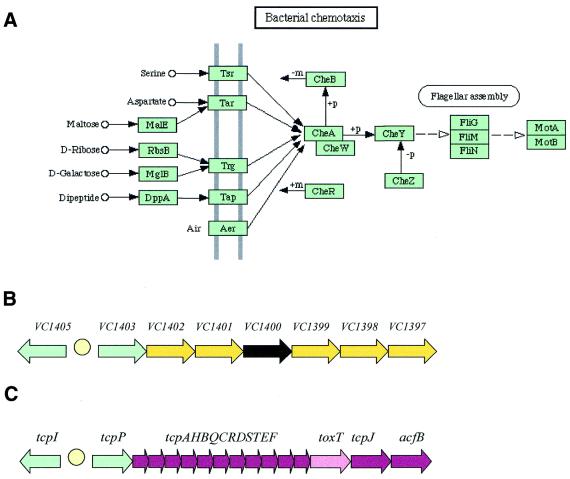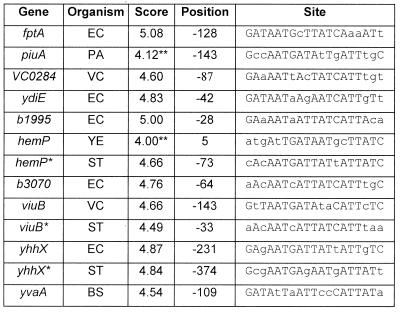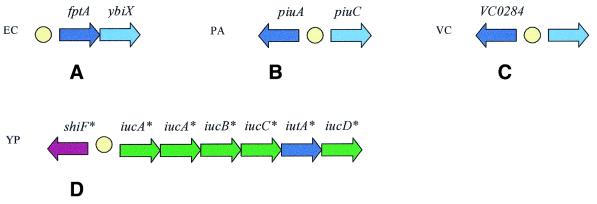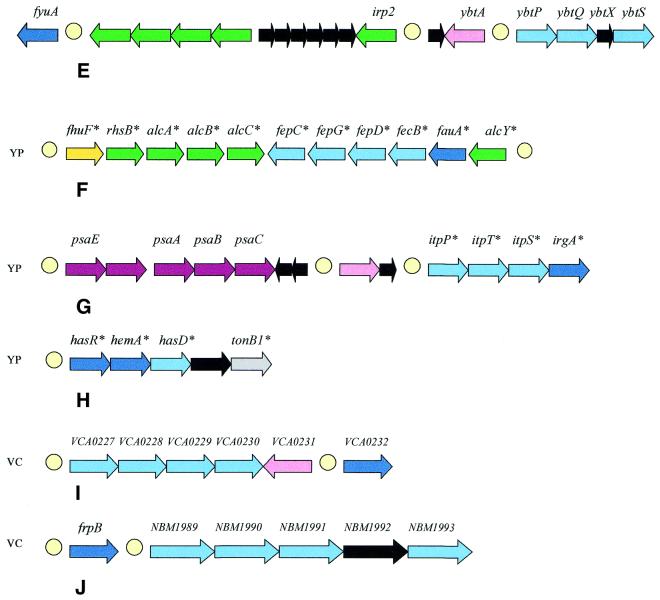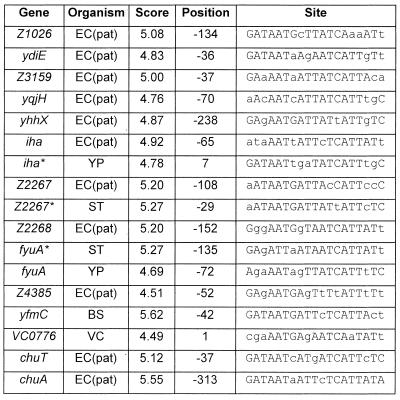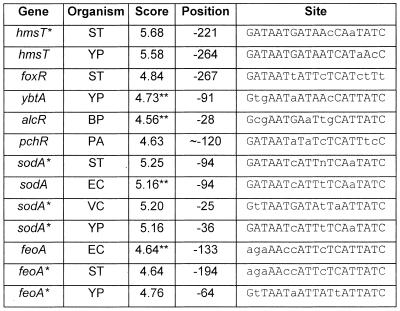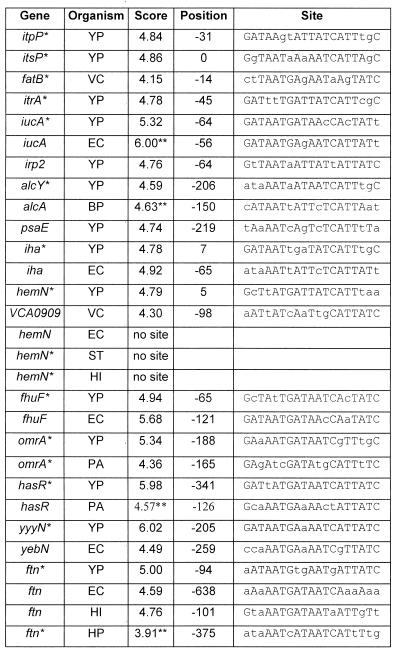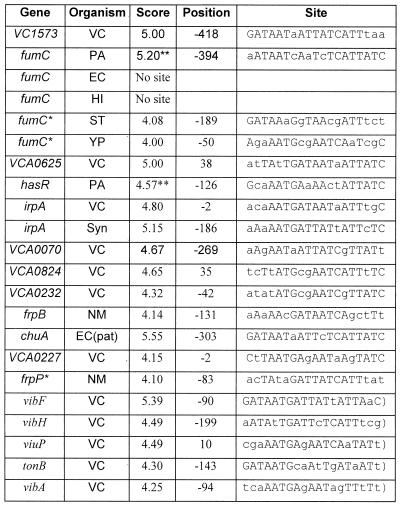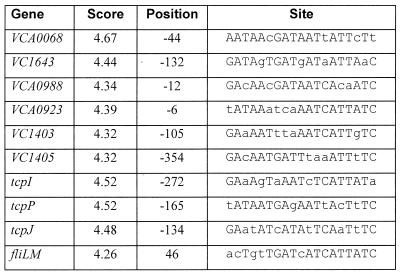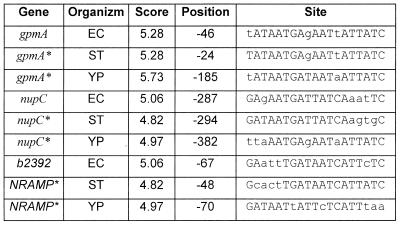Abstract
Iron is an essential element for the survival and pathogenesis of bacteria. The strict control of iron homeostasis is mediated by the FUR repressor, which is highly conserved among various bacterial species. Here we apply the comparative genomics approach to analyze candidate Fur-binding sites in the genomes of Escherichia coli (K12 and O157:H7), Salmonella typhi, Yersinia pestis and Vibrio cholerae. We describe a number of new loci encoding siderophore biosynthesis and transport proteins. A new regulator of iron-acquisition systems was found in S.typhi. We predict FUR regulation for several virulence systems. We also predict FUR regulation for the chemotaxis system of V.cholerae that is probably involved in the process of pathogenesis.
INTRODUCTION
Iron is necessary for the growth of most bacteria. Therefore, efficient iron-acquisition mechanisms must be employed when bacteria are facing iron-restricted conditions such as the host environments for pathogenic strains. Many microorganisms secrete siderophores, high-affinity iron III chelators. Then the Fe(III)–siderophore complexes are taken up into the cell via specific transport systems usually including a TonB-dependent outer membrane receptor and an ATP-binding type transporter (1).
Escherichia coli is known to synthesize two types of siderophores: enterobactin and aerobactin, and it also utilizes such exogenous siderophores as ferrichrome, ferridicitrate, coprogen and rhodotorulic acid (1). In the E.coli genome, the iron uptake systems are encoded by more than 20 genes that form several operons: the aerobactin biosynthesis and uptake system iucABCDiutA (2); the ferrichrome-uptake system fhuACDB (3); the uptake/sensory system for the ferridicitrate complexes, fecIRABCDE (4); and large locus-containing genes for enterobactin biosynthesis (entABCDEFG) and uptake (fepABCDEG) organized in five small operons (1). There are also several other proteins involved in iron acquisition: FhuE is a coprogen and rhodotorulic acid receptor, and its gene fhuE is located separately from other fhu genes (5); Fes, encoded by the first gene of the fes-entF-fepE operon, is a protein that hydrolyzes enterobactin, thus facilitating Fe(III) reduction to Fe(II) (6). Finally, the TonB–ExbBD complex provides energy that allows the ferrisiderophores to enter the periplasm through the outer membrane (7).
Although iron is indispensable, its excess in the cytoplasm is toxic for the cell, as it catalyzes the Fenton reaction, leading to formation of hydroxyl radicals (OH·) (8). Thus, iron homeostasis is strictly controlled. In Enterobacteriaceae this control is mediated by Fur (Fe uptake regulator) and its orthologs (2,9). In E.coli, in the presence of iron, Fur binds DNA and represses the transcription of all genes involved in siderophore biosynthesis and transport except for tonB and exbBD (2). A 19-bp consensus Fur-binding site (FUR-box) GATAATGATAATCATTATC was proposed to be based on DNase I protection and footprinting experiments (10,11).
The availability of complete genomes of related bacteria allows one to apply the comparative approach to the analysis of regulatory patterns. An important advantage of simultaneous analysis of several genomes is the possibility of distinguishing true sites, occurring upstream of orthologous genes, from false positives scattered at random across the genome (12,13). The latter technique allowed us and other groups to analyze several regulons and to obtain a number of promising predictions (14–18). Here we apply this technique to analyze Fur regulation in the genomes of E.coli (K12 and O157:H7), Salmonella typhi, Yersinia pestis and Vibrio cholerae. As iron-acquisition systems are often located on plasmids or within transposable pathogenicity islands, they are a frequent subject of horizontal transfer (19,20). Thus, these systems are widely distributed among various bacterial species, but even closely related genomes can contain different sets of systems. This makes the standard orthology analysis inapplicable in many cases.
On the other hand, the Fur protein is conserved not only within Gram-negative, but also within Gram-positive bacteria (21,22). Its recognition signal is conserved as well (23,24).
Thus, in this study we modified the basic comparative technique (13), accepting a site upstream of a functionally relevant gene if either of the following conditions was met: (i) there were candidate sites upstream of all orthologous genes in genomes from the same taxonomic group, gamma-proteobacteria; (ii) there was an experimentally verified site upstream of a closely homologous gene from another genome; (iii) in case there was an orthologous gene with no candidate site in the same taxonomic group, there were at least two candidate sites upstream of homologous genes from distant species and (iv) in the case of no orthologous genes being found, the function was directly involved in iron acquisition (Table 1). Additionally, a chain of functionally related genes transcribed in the same direction and with small intergenic distances was assumed to form a candidate operon, and a candidate site upstream of this operon was accepted as the one regulating all genes in the chain. Thus, we identified a number of potentially Fur-regulated genes encoding ferrisiderophore transport systems and other proteins involved in the iron acquisition.
Table 1. The decision procedure.
| Close genomes from the same taxonomic group | Experimentally verified sites upstream of some closely homologous genes | Distant genomes | ||
|---|---|---|---|---|
| Candidate sites upstream of some homologous genes | No candidate sites upstream of homologous genes | No homologous genes | ||
| Candidate sites upstream of all orthologous genes | Accept a candidate site | Accept a candidate site | Accept a candidate site | Accept a candidate site |
| Candidate sites upstream of some orthologous genes | Accept a candidate site | Accept a candidate site | Reject a candidate site | Reject a candidate site |
| No orthologous genes, but relevant function | Accept a candidate site | Accept a candidate site | Reject a candidate site | Accept a candidate site |
Many bacterial pathogens use the low concentration of iron present in the host as an environmental clue to enhance the expression of a wide variety of bacterial toxins and other virulence determinants (25). In various bacterial species, chemotaxis plays an important role during pathogenesis. In particular, the E.coli chemotaxis system includes methyl-accepting chemotaxis proteins (MCPs), che-system for signal transduction and MotAB, FliMNG system for flagellar rotation (see Fig. 3A) (26). Here we present a new Fur-dependent chemotaxis system of this type, which is probably used by V.cholerae during its pathogenesis. Some other virulence systems are also proposed to be under the Fur control.
Figure 3.
The alignment of Fur proteins from E.coli, S.typhi, Y.pestis and V.cholerae. Amino acids of the DNA recognition helix are shown in yellow. Lys76, which also might interact directly with DNA, is shown in green.
MATERIALS AND METHODS
The complete genome sequences of E.coli (both K12 and O157:H7), Haemophilus influnzae, V.cholerae and Pseudomonas aeruginosa were extracted from GenBank (27). Partially sequenced genomes of S.typhi, Y.pestis and Shewanella putrefaciens were extracted from the TIGR WWW site (http://www.tigr.org). In several cases, additional analyses were done on sequence fragments extracted from GenBank (27).
Known E.coli Fur-binding sites were taken (1) and a signal recognition profile was constructed. The quality of the profile was defined as its informational content (28). Then we retained all the sites from the first sample with scores exceeding 4.5 (Table 2) and computed the profile used in this study.
Table 2. The training set.
Positional nucleotide weights in this profile are defined as:
W(b,k) = log[N(b,k) + 0.5] – 0.25Σi=A,C,G,Tlog[N(i,k) + 0.5],
where N(b,k) is the count of nucleotide b at position k. The score of a candidate site is calculated as the sum of the respective positional nucleotide weights:
Z(b1 … bL) = Σk=1 … L W(bk,k),
where L is the length of the site. The cut-off value for candidate FUR-boxes in E.coli, S.typhi and Y.pestis was 4.5. The cut-off value for candidate FUR-boxes in V.cholerae was 4.25.
The DNA-binding motif in the FUR protein has been identified recently (29). This motif is strictly conserved in the Fur proteins from E.coli, S.typhi, Y.pestis and V.cholerae (Fig. 1). This allows us to use the same profile for the recognition of FUR-boxes in all studied genomes. However, several amino acids close to the recognition helix in V.cholerae Fur protein are different from those in the other studied genomes. As the DNA recognition domain in the Fur protein has a non-classical, not absolutely understood structure (29), these amino acids might play some role in the sequence-specific DNA binding. Thus, we decreased the cut-off for the V.cholerae genome to 4.25.
Figure 1.
(A–C) The structure of three homologous iron-acquisition loci of: (A) E.coli, (B) P.aeruginosae and (C) V.cholerae. The gene orf1 homologous to the iron uptake factors of E.coli and P.aeruginosa is missed in the annotation of the full genome of V.cholerae. (D–F) The structure of three siderophores-biosynthesis loci of Y.pestis. (G) The structure of Y.pestis locus that consists of the iron ABC transporter, the outer membrane receptor, the putative transcriptional regulator and the virulence-associated psa system. (H) The structure of the heme-acquisition locus of Y.pestis. (I and J) The structure of two iron-transport systems of (I) V.cholerae and (J) N.meningitis. Genes are shown by arrows, candidate FUR-boxes are shown by yellow circles. Blue arrow, the gene for iron ABC transporter; violet arrow, the gene for outer membrane ferrisiderophore receptor; lilac arrow, the gene for virulence-associated protein; pink arrow, the gene for transcriptional regulator; green arrow, the gene for siderophore-biosynthesis protein; yellow arrow, the gene for iron reductase; grey arrow, the gene for tonB protein; black arrow, other genes.
The cut-off 4.5 is passed by 12 out of 16 experimentally confirmed Fur-binding sites from the E.coli genome. Decreasing the cut-off to 4.25 in E.coli doubles the number of genes with candidate FUR-boxes. However, few genes with the site score <4.5 have a function related to iron metabolism. Nevertheless, we retained genes with sites scoring <4.5 (but >4.00) if they had orthologs with strong candidate sites, or were known to be regulated by Fur. We also recorded low-scoring candidate Fur-boxes within large iron-acquisition loci.
At the cut-off 4.5 we found four FUR-boxes out of 60 predicted (after comparative analysis) lie within coding regions. Database similarity searches were done using BLAST (http://www.ncbi.nlm.nih.gov/blast/). Multiple protein alignments and phylogenetic trees were constructed using CLUSTALX (30). Genomic analyses (protein similarity search, analysis of orthology, DNA profile search) were done using GenomeExplorer (31). The gene names suggested in this paper, based on homology and regulatory analyses, are marked by stars.
RESULTS
The profile made using known E.coli Fur-binding sites (see Materials and Methods) was applied to detect new candidate FUR-boxes in the genomes of E.coli, S.typhi, Y.pestis and V.cholerae.
The profile search in the E.coli K12 genome identified 73 genes having candidate FUR-boxes in the region (–300 … +20) relative to the start of translation. A complete table of orthologous genes was constructed for the genomes of S.typhi, Y.pestis, V.cholerae, H.influenzae, P.aeruginosa and S.putrefaciens. For those genes that had no orthologs or close homologs in the above genomes, homologs in distant species were identified using BLAST (http://www.ncbi.nlm.nih.gov/blast/). Then the E.coli K12 profile was used to identify the candidate FUR-boxes upstream of orthologous and homologous genes in the other genomes. As a result, six new candidate Fur-regulated genes were found.
The same procedure was applied to the genomes of E.coli O157:H7 (–300 … +50), S.typhi (–400 … +100 relative to the start codons), Y.pestis and V.cholerae (–500 … +100 relative to the start codons). The candidate sites within coding regions of upstream genes (deeper than 50 nt) were excluded. The number of genes with candidate FUR-boxes in the four genomes was 89, 75, 88 and 94, respectively.
In all five genomes, the profile search selected a number of experimentally confirmed FUR-boxes. They are not discussed below unless these genes have been used for the verification of candidate sites.
Below we carefully describe the predicted Fur-regulons from the genomic perspective. The functional overviews are given in the Discussion. The evolutionary perspective is presented in the Conclusion.
Candidate FUR-boxes in the E.coli K12 genome
Table 3 shows E.coli genes with new candidate FUR-boxes: fptAybiX, ydiE, b1995, b3070, yhhX.
Table 3. The predicted FUR-boxes upstream of the iron-acquisition genes of E.coli and the FUR-boxes upstream of the homologous genes in other genomes.
Genome abbreviation: EC, E.coli K12; ST, S.typhi; YP, Y.pestis; VC, V.cholerae; PA, P.aeruginosa; YE, Y.enterocolitica; BS, B.subtilis.
*Genes that have no common name or have been identified previously as open reading frames only. These genes are named after orthologs from other genomes.
**Experimentally confirmed Fur-binding sites.
The genes fptAybiX are likely to form an operon, as the length of the intergenetic region is only 6 nt. We have found a strong candidate FUR-box upstream of fptA (Table 3 and Fig. 2A). In the study by Oshima et al. (32), fptA was annotated as a Fe(III)–pyochelin receptor due to its similarity to the P.aeruginosa gene piuA with the same function. The corresponding locus in the P.aeruginosa genome is shown in Figure 2B. It also includes piuC, the ortholog of ybiX that encodes an iron-uptake factor, and a strong FUR-box (Table 3). The arrangement of genes in P.aeruginosa is different, as piuA and piuC are divergently transcribed (Fig. 2B). This system was shown to be regulated by the P.aeruginosa analog of the Fur (33). A locus similar to that of P.aeruginosa was found in the genome of V.cholerae (Fig. 2C). It also has a strong FUR-box (Table 3), although nothing is known about its regulation by Fur protein.
Figure 2.
(A) The chemotaxis system of E.coli (taken from KEGG; 61). (B) One of the three loci containing che genes. The homologs of cheW, cheB, cheR, cheY and cheA are shown by the yellow arrows, genes encoding the MCPs are shown by the light green arrows. (C) The Tcp-encoding locus. The tcp genes similar to MCPs are represented by the light green arrows. All other tcp genes are represented by lilac arrows. The gene for the regulator ToxT is shown by the pink arrow
The ydiE and b1995 genes are located separately in the genome of E.coli. Each of them has a strong upstream FUR-box (Table 3). BLAST revealed their similarity to the Yersinia enterocolitica haemin uptake proteins HemP (haemin-uptake factor) and HemR (haemin receptor), respectively (with E-values 9e-04 and 3e-07). In the genome of Y.enterocolitica, hemR and hemP form an operon. A FUR-box was described in its operator region and the iron-dependent transcription of hemP was shown (34). In the genome of S.typhi there is a locus similar to that described in Y.enterocolitica. It contains strong homologs of hemP and hemR, and a strong FUR-box (Table 3).
The next E.coli gene with a candidate FUR-box, b3070 (Table 3), is orthologous to viuB from V.cholerae (E-value 4e-15). This gene encodes an iron-chelator utilization protein. In V.cholerae, viuB belongs to the iron-acquisition locus vuiAiuBviuF shown to be regulated by Fur (35). Transcription of viuB is iron dependent and it has a candidate FUR-box in the promoter region (Table 3) (36). The ortholog of viuB from S.typhi also has an upstream candidate FUR-box (Table 3).
The gene yhhX is a putative oxidoreductase. The possible role of oxidoreductases in the iron uptake is discussed below (see Discussion). We have found a candidate FUR-box upstream of this gene and upstream of its homolog yvaA in the genome of Bacillus subtilis (Table 3). The E.coli genome contains a gene b1624 with stronger similarity to yvaA (44% identity compared with 30%) and no FUR-box. The S.typhi ortholog of yhhX also has a candidate FUR-box (Table 3). After this study was completed, the FUR-box upstream of yhhX was experimentally confirmed (37).
Candidate FUR-boxes in the E.coli O157:H7 genome
Table 4 shows E.coli O157:H7 genes with new candidate FUR-boxes: Z2267, Z2268, chuTWXYUV*, z4912chuAS, Z1026ybiX, Z3159, Z1178, Z1617, ydiE, yqjH, Z4385-Z4382, Z4386, yhhX.
Table 4. The predicted FUR-boxes upstream of the iron-acquisition genes of E.coli O157:H7 and the FUR-boxes upstream of the homologous genes in other genomes.
Genome abbreviation: EC(pat), E.coli O157:H7; see also Table 3.
*Genes that have no common name or have been identified previously as open reading frames only. These genes are named after orthologs from other genomes.
Some of these genes have already been described in the above paragraph. Z1026 and ybiX from E.coli O157:H7 are orthologs of the fptA and ybiX from E.coli K12, respectively; Z3159 and ydiE are orthologs of b1995 and ydiE; yqjH is orthologous to b3070; yhhX has the same name in both genomes.
A new gene iha encoding an adhesin was recently discovered in the pathogenic strain of E.coli O157:H7 (38). Actually, in the genome of E.coli O157:H7 there are two identical genes for the Iha adhesin, Z1178 and Z1617. We have found strong FUR-boxes upstream of both genes (Table 4), and the FUR-box is conserved upstream of the orthologous gene in the genome of Y.pestis (see below).
Z2267 and Z2268 form a divergon. Z2267 encodes a putative receptor with a candidate role in enterotoxin production, determined by homology to the S.typhi gene with the same function. Z2268 encodes a putative receptor for iron transport (as annotated in GenBank). A candidate FUR-box was observed in the intergenetic region of Z2267 and Z2268 (Table 4). It is conserved in the genomes of S.typhi and Y.pestis. In the latter case there are no orthologs for Z2267 and the signal was found only upstream of fyuA, a Z2268 ortholog with 24% identity.
The genes Z4385–Z4382 encode an iron ABC transporter, whereas the divergent gene Z4386 encodes an iron-compound receptor. We have found a candidate FUR-box in the Z4385–Z4386 intergenic region (Table 4). The Z4385–Z4382 operon is similar to the iron ABC transporter of B.subtilis yfmCDEF and to the ferric vibriobactin ABC transporter of V.cholerae VC0776–VC0779 (although the arrangement of genes in both cases is different). Candidate FUR-boxes precede both yfmC and VC0776.
Escherichia coli O157:H7 also has a large locus of genes involved in iron acquisition with no orthologs in E.coli K12 and S.typhi. This locus includes: chuTWXYUV* and divergent Z4912-chuAS. The first gene, chuT, encodes a putative periplasmic-binding protein, chuW encodes a putative oxygen independent coproporphyrinogen III oxidase and chuX and chuY are unknown open reading frames. Further, chuU encodes a putative permease of iron-compound ABC transport system, and chuV* (Z4919) encodes a hypothetical protein highly similar to ATPases of iron ABC transporters. Finally, Z4912 is an unknown open reading frame, chuA encodes an outer membrane heme/hemoglobin receptor, and chuS encodes a putative heme/hemoglobin transport protein. A strong candidate FUR-box was found in the Z4912-chuT intergenic region. This system was also found in the genomes of Y.pestis and V.cholerae and in a reduced form in the genomes of S.putrefaciens and P.aeruginosa. The arrangement of genes in each case is unique, but a candidate FUR-box is always present in the regulatory region. There is a large intergenic space of 216 nt between Z4912 and chuA. We have found another strong candidate FUR-box upstream of chuA, although it overlaps with Z4912.
Candidate FUR-boxes in the S.typhi genome
The S.typhi genes with new candidate FUR-boxes are feoAB, sodA, hmsT*, foxR* (Table 5).
Table 5. The predicted FUR-boxes upstream of the iron-acquisition genes of S.typhi and the FUR-boxes upstream of the homologous genes in other genomes.
Genome abbreviation: BP, B.pertussis; see also Table 3.
*Genes that have no common name or have been identified previously as open reading frames only. These genes are named after orthologs from other genomes.
**Experimentally confirmed Fur-binding sites.
Two systems, feoAB for Fe(II) transport and sodA encoding the superoxide dismutase, are known to be regulated by Fur in E.coli (1). There are candidate FUR-boxes upstream of the sodA orthologs in the genomes of S.typhi, Y.pestis and V. cholerae (Table 5). Candidate FUR-boxes upstream of the orthologs of feoAB were found in the genomes of S.typhi and Y.pestis (Table 5).
The gene hmsT* from S.typhi is an ortholog of hmsT from Y.pestis that encodes a haemin storage protein. Both genes have candidate FUR-boxes (Table 5). In Y.pestis, the hms-phenotype was shown to be regulated by Fur (39). In the genome of S.typhi this gene is followed by an ortholog of fhuF, the Fur-regulated gene from E.coli.
FoxR* of S.typhi is an AraC/XylS-type regulator. This gene has a candidate FUR-box. There are candidate FUR-boxes upstream of closely related regulators in other genomes (alcR, ybtA, pchR; Table 5). The gene alcR from Bordetella pertussis was shown to be regulated by Fur (40); ybtA from Y.pestis belongs to the yersiniabactin biosynthesis locus and and its expression is Fur dependent (41); pchR from P.aeruginosa is likely to be regulated by Fur (42). Besides, all three proteins regulate transcription of Fur-regulated iron-acquisition systems. AlcR and YbtA act in cis, the target of PchR is located not further than 14 kb from the pchR gene. Given these observations, we propose the foxA gene as a candidate target for the regulation by FoxR*. Indeed, it is located immediately downstream of foxR, it has a strong FUR-box (43) and the product of foxA functions as a ferrisiderophore receptor.
Candidate FUR-boxes in the Y.pestis genome
Table 6 shows Y.pestis genes with new candidate FUR-boxes: itpPTS*, itsPTUS*, itrAS*, irp2, iucABCDiutA*, alcABC*, aclY*, psaE, iha*, hemN*, fhuE*, omrA*, hasR* and yebN*.
Table 6. The predicted FUR-boxes upstream of the iron-acquisition genes of Y.pestis and the FUR-boxes upstream of the homologous genes in other genomes.
Genome abbreviations: HI, H.influenzae; HP, Helicobacter pylori; see also Tables 3 and 5.
*Genes that have no common name or have been identified previously as open reading frames only. These genes are named after orthologs from other genomes.
**Experimentally confirmed Fur-binding sites.
We propose the name Itp* (iron transport) for a new candidate Fe(III) ABC transporter, which was found in the Y.pestis genome. The Itp system consists of a periplasmic-binding protein (ItpP*), a transmembrane protein (ItpT*) homologous to the members of the FecC/D iron permease family (BLAST E-value 3e-47) and an ATPase (ItpS*) homologous to the ATP-binding protein VC0779 of the V.cholerae ferric vibriobactin ABC transporter (BLAST E-value 3e-28). Besides, the gene located immediately downstream of itpS* has a strong similarity to the iron-regulated outer membrane ferrisiderophore receptor irgA from V.cholerae. There is a candidate FUR-box upstream of itpP* (Table 6).
One more candidate Fe(III) ABC transporter found in the genome of Y.pestis was named Its* (iron transport system). It includes a periplasmic protein (ItsP*), two transmembrane proteins (ItsT*, ItsU*) and an ATPase (ItsS*). There is a candidate FUR-box upstream of itsP* (Table 6). Iron transporter systems similar to Its exist in the genomes of V.cholerae and Vibrio angulliarrium (fatDCBA). The gene fatB is the ortholog of itsP. The Fur-dependent regulation of fatBA in V.angulliarrium was shown in Actis et al. (44). Although Fur does not bind to the fatB promoter, it regulates the expression of the latter indirectly by binding to the promoter of the antisense RNA. (45). We have found a candidate FUR-box upstream of the itsP ortholog in the genome of V.cholerae (Table 6). Nothing is known about the antisense RNA regulation of this transporter in V.cholerae. Thus, the antisense RNA regulation might be unique for the V.anguillarium system. Although the absence of a Fur-binding site upstream of fatB does not allow us to invoke the general rule (Table 1), we still predict the Fur-repressible transcription of the itsPTUS operon.
One more iron transport locus in the genome of Y.pestis includes a candidate outer membrane siderophore receptor itrA* and a gene itrS* (iron transport). We have assigned the function of ItrS* as an iron transport ATPase by sequence similarity to the ItpS*/vibriobactin protein family. A strong candidate FUR-box was observed upstream of itrA* (Table 6).
Two Y.pestis genes encoding siderophore-biosynthesis proteins, iucA* and irp2, also have candidate FUR-boxes in their upstream regions (Table 6). The former gene is a homolog of the Fur-regulated gene iucA from E.coli (BLAST E-value, 4e-29) and Shigella flexneri (BLAST E-value, 5e-30). In E.coli, the operon iucABCD encodes proteins for aerobactin biosynthesis. In Y.pestis, iucA* also belongs to a siderophore-biosynthesis cluster that includes homologs of iucB, iucC and iucD (Fig. 2D). The product of irp2 participates in yersiniabactin biosynthesis (46) and it lies within a large yersiniabactin biosynthesis and uptake locus with one known and two candidate FUR-boxes (Fig. 2E).
One more siderophore-biosynthesis gene cluster alcABC* is probably regulated by Fur. The alcABC* genes lie downstream of genes fhuF* and rhsB*, and most likely form an operon with the latter (Fig. 2F). FhuF* is 37% identical to the FhuF protein from E.coli. The latter is involved in the reduction of ferric iron in cytoplasmic ferrioxamine B (47). RhsB* is homologous to the siderophore-biosynthesis protein RhsB from B.subtilis. A strong FUR-box was found upstream of the fhuF* gene in Y.pestis (Table 6). In the genome of E.coli, fhuF is also preceded by a strong FUR-box. The genes alcABC* are homologous to the alcaligin-biosynthesis genes alcABC from B.pertussis (BLAST E-value, e-156). The FUR-box was observed upstream of the alcABC operon in the genome of B.pertussis and the transcription of alcABC is iron dependent (48). Moreover, in the genome of Y.pestis, the fhuF*rhsB*alcABC* operon lies within the locus containing other genes involved in the biosynthesis and transport of siderophores (Fig. 2F). One of them is alcY*, which is 50% identical to alcC*. It is also preceded by a candidate FUR-box (Table 6). The downstream gene of alcY* fauA*, similar to a gene for ferric alcaligin siderophore receptor from B.pertussis (BLAST E-value, e-147).
A strong candidate FUR-box was found upstream of psaE, the transcriptional regulator of biosynthesis of the Y.pestis pH6 antigen (Table 6). This antigen plays an essential role in the pathogenesis of Y.pestis (49) and the psa genes are co-localized with some iron-uptake systems (Fig. 2G). The role of Fur in the regulation of virulence systems is discussed below.
One more candidate Fur-regulated operon with a function in the pathogenesis is ihaAB* (Table 6). The gene ihaA* encodes an adhesin similar to the one produced by the pathogenic strain of E.coli O157:H7 (iha). The latter also has an upstream candidate FUR-box (Table 3; see above). The gene ihaB* encodes an exogenous ferric siderophore receptor.
The genes encoding coproporphyrinogen oxidase in Y.pestis (chuW*), E.coli O157:H7 (chuW) and in V.cholerae (VCA0909) all have candidate FUR-boxes (Table 6). They probably participate in the Fe(III) reduction after it is delivered to the cytoplasm.
Two new Y.pestis outer membrane receptors with candidate FUR-boxes are omrA* and hasR*. OmrA* is homologous to the members of the ferrisiderophore receptor family including FyuA and FhuA from E.coli. The closest homolog of omrA* was found in the genome of P.aeruginosa, where it also has a candidate FUR-box (Table 6). The second gene, hasR*, is an ortholog of hasR from P.aeruginosa, encoding a heme receptor. Although the candidate FUR-box of hasR in P.aeruginosa is weak (Table 6), the Fur-regulated transcription of this gene was shown experimentally (50). In Y.pestis, hasR* lies in a locus containing other iron-acquisition genes (Fig. 2H).
The gene yebN* encoding a hypothetical membrane protein has a very strong candidate FUR-box. The orthologous gene yebN of E.coli also has a candidate upstream FUR-box (Table 6). In the Y.pestis genome a gene for a ferrichrome receptor follows this gene.
Candidate FUR-boxes in the V.cholerae genome
Tables 5 and 7 show V.cholerae genes with new candidate FUR-boxes: VC1573, VCA0625, irpA, VCA0070, VCA0824, VCA0232, VCA0227, VCA0284, VCA0068, VC1643, VCA0988, VCA0923, VC1403, VC1405, tcpI, tcpP, cheY, fliLM.
Table 7. The predicted FUR-boxes upstream of the iron-acquisition genes of V.cholerae and the FUR-boxes upstream of the homologous genes in other genomes.
Genome abbreviation: Syn, Synechococcus; NM, N.meningitis; see also Tables 3 and 6.
*Genes that have no common name or have been identified previously as open reading frames only. These genes are named after orthologs from other genomes.
**Experimentally confirmed Fur-binding sites.
VC1573 has a strong candidate FUR-box. It is similar to the fumarate hydratase genes fumC from E.coli (46% identity), P.aeruginosa (65% identity) and other Enterobacteraceae. The transcription of fumC from P.aeruginosa is regulated by Fur and there is a known Fur-binding site upstream of the fumC-containing operon in P.aeruginosa (51). However, no FUR-boxes were found upstream of fumC in E.coli and H.influenzae, and only weak candidate FUR-boxes were observed upstream of fumC in S.typhi and Y.pestis (Table 7).
The product of VCA0625 was annotated as a TonB receptor-related protein (similar to the heme receptor HasR from P.aeruginosa and Serratia marcescens). A candidate FUR-box was observed upstream of this gene and upstream of the orthologous gene from P.aeruginosa (Table 7).
There is a candidate FUR-box upstream of VC1264 (Table 7). This gene is similar to irpA from Synechococcus. In Synechococcus, irpA is expressed only under iron-deficient conditions and this gene also has a candidate Fur-binding site in the upstream region (Table 7) (52).
VCA0824 encodes a protein similar to diaminobutyrate aminotransferases. This gene has a candidate FUR-box site in the upstream region (Table 7), whereas its product is similar to RhsA, a rhizobactin siderophore-biosynthesis protein from Sinorhizobium meliloti.
A new iron-acquisition locus with two candidate FUR-boxes consists of the ABC-transporter operon VCA0227–VCA0230 and the gene VCA0232 encoding an outer membrane protein (Fig. 2I). The product of VCA0232 is similar to FrpB (iron-regulated TonB-dependent outer membrane protein) from Neisseria meningitis and ChuA (heme utilization outer membrane protein) from the pathogenic strain of E.coli O157:H7. The genes of all three outer membrane receptors have upstream candidate FUR-boxes (Table 7). The Fur-dependent regulation of chuA has already been shown (53). The operon frpPTUS homologous to the ABC-transport operon VCA0227–VCA0230 is present in the genome of N.meningitis (54) where it lies immediately downstream of frpB (Fig. 2J). In both genomes, V.cholerae and N.meningitis, there are candidate FUR-boxes upstream of the transporter operons (Table 7).
One more iron-acquisition system (VC0284 and ybiX*), which is likely to be regulated by Fur, consists of an outer membrane TonB-dependent receptor and an iron-uptake factor (Fig. 2C). This system is similar to the E.coli and P.aeruginosa iron-acquisition systems (see above).
The profile we used pulled out several V.cholerae genes that had already been described as having candidate FUR-box in the upstream regions, namely vibF (55), vibH (56), viuP (56), tonB (57) and vibA (58).
Unexpectedly, a large set of genes involved in chemotaxis were found to have candidate FUR-boxes in the upstream regions. These genes encode eight MCPs (VCA0068, VC1643, VCA0988, VCA0923, VC1403, VC1405, tcpI, tcpP); homologs of the E.coli chemotactic signal transducing proteins, VC1397 (cheA), VC1401 (cheB), VC1399 (cheR), VC1402 (cheW) and VC1398 (cheY); a flagellar motor switch protein VC2126 (fliM); a homolog of fliL, VC2127. All mentioned E.coli genes are involved in the sequential steps of chemotaxis (Fig. 3A) (26). Escherichia coli has only five MCPs: tar, tap, air, trg, tsr and only one copy of each che-gene: cheA, cheW, cheR, cheB, cheY, cheZ. On the contrary, more than 40 MCPs were found in the genome of V.cholerae and there are three large loci with che-like genes. A candidate FUR-box was observed upstream of the locus containing genes least similar to the E.coli che-genes (Fig. 3B). Table 8 shows candidate FUR-boxes upstream of V.cholerae MCPs, che-like genes and fliLM homologs. The chemotaxis plays an important part in the V.cholerae pathogenesis (59). Indeed, two of the MCPs with candidate FUR-boxes (tcpI and tcpP) are the members of the toxin co-regulated pilus-biosynthesis cluster (Fig. 3C). The role of Fur in the pathogenesis is discussed below (see Discussion).
Table 8. The candidate FUR-boxes upstream of genes encoding MCPs in the V.cholerae genome.
Some exceptions
The profiles and comparison-based filters produced three more genes with conserved Fur-box-like sequences in the upstream regions, but the functions of these genes were not linked to the iron metabolism (Table 9). Thus, they seem to be false positives. These genes are: gpmA (phosphoglycerate mutase 1 involved in glycolysis), nupC (nucleoside permease) and b2392 (NRAMP manganese transport protein) in the genome of E.coli (both strains) and their orthologs in the genomes of S.typhi and Y.pestis.
Table 9. Sequences similar to FUR-boxes upstream of genes with no direct function in iron acquisition.
*Genes that have no common name or have been identified previously as open reading frames only. These genes are named after orthologs from other genomes.
DISCUSSION
This study identified a number of likely Fur-regulated genes in the genomes of E.coli, S.typhi, Y.pestis and V.cholerae. Most of these genes either are known to function in iron acquisition and metabolism or exhibit significant homology to proteins of such systems. The presence of FUR-boxes upstream of the latter genes allows us to ascribe the function in iron metabolism to them with higher confidence. Thus, a number of new iron-acquisition mechanisms were described, although this annotation still requires an experimental confirmation. Here we describe the role of Fur in the biosynthesis of the new siderophores and the regulation of the ferrisiderophore-uptake pathways; the fate of the Fe(III) ion taken into the cytoplasm, the regulation of the enzymes involved in the Fe(III) reduction and protection of the free iron. Finally, we discuss the role of Fur as a global regulator of pathogenesis.
Siderophore biosynthesis
Several new siderophore biosynthesis genes were found in the genomes of Y.pestis and V.cholerae. In the genome of Y.pestis there are two new loci. One of them contains genes similar to the aerobactin-biosynthetic operon of E.coli and S.flexneri, whereas the other contains genes similar to the alcaligin-biosynthetic operon of B.pertussis (Fig. 2D and F). Both gene clusters are preceded by candidate FUR-boxes and their transcription is likely to be Fur regulated. Vibrio cholerae has a gene homologous to rhsA from S.meliloti that encodes the first enzyme of the rhizobactin-biosynthesis pathway. It has also an upstream candidate FUR-box and, given its function, is likely to be under the regulation of Fur.
Iron-uptake systems
A new family of iron-acquisition systems was identified in E.coli (fptAybiX) and V.cholerae (VCA0284, ybiX*). Each system consists of a TonB-dependent outer membrane receptor (fptA, VCA0284) and an iron-uptake factor (ybiX, ybiX*). A similar system was found in P.aeruginosa (piuAC), where it is known to be regulated by Fur (33) (Fig. 2A–C). So we propose Fur regulation for the E.coli and V.cholerae systems as they also have candidate FUR-boxes.
Three new Fe(III)-ABC transporters of Y.pestis (itpPTS*, itsPTUS* and itrAS*) were identified by sequence similarity to iron-transport systems of other bacteria. Their regulation by Fur was predicted based on the following observation: the presence of FUR-boxes, the localization of the genes within large iron-acquisition loci and, in the case of its*, the conservation of the site in the genome of V.cholerae.
A new hemin-uptake system probably regulated by Fur is described in E.coli and S.typhi. In the genome of E.coli, it is encoded by two separately located genes b1995 and ydiE. Each of them is preceded by a candidate FUR-box. In the genome of Y.enterocolitica these genes, hemP* and hemR*, are immediately adjacent and transcribed in the same direction. A similar system has already been identified in Y.pestis, where these two genes are divergently transcribed from Fur-dependent promoters (34).
One likely Fur-regulated Fe(III) transport system is described in the genome of V.cholerae. It includes the outer membrane receptor VCA0232 and the ABC transporter VCA0227–VCA0231. Both VCA0232 and VCA0227 are preceded by candidate FUR-boxes. A similar system was found in N.meningitis (frpB and frpPTUS*). Both frpB and frpP* are preceded by candidate FUR-boxes.
Three new outer membrane ferrisiderophore and hemin receptors seem to be under Fur regulation in the genomes of Y.pestis and V.cholerae: omrA*, hasR* (Y.pestis) and VCA0625 (V.cholerae).
Fe(III) release
As Fe(II) is bound by siderophores weaker than Fe(III), the enzymatic reduction of iron as a release mechanism has been proposed (1). We predict that this function is encoded by the oxidoreductase gene yhhX from E.coli, because this gene has candidate FUR-boxes in the genomes of E.coli, S.typhi and B.subtilis.
Coproporphyrine oxidases from Y.pestis (hemN*) and V.cholerae (VCA0909) also have candidate FUR-boxes in both genomes and thus they are likely to be regulated by Fur.
The gene fhuF* has FUR-boxes in Y.pestis and E.coli and it is probably involved in the reduction of the ferric iron in the cytoplasmic ferrisiderophores.
We also propose Fur regulation for the E.coli gene b3070, whose product is homologous to the iron-chelator utilization protein ViuB of V.cholerae.
Superoxide dismutase
Manganese-containing superoxide dismutase, encoded by the gene sodA, plays a crucial role in maintaining low intracellular levels of the superoxide radical (O2–). The superoxide can directly cause cell damage. Besides, the reduction of iron by the superoxide and the presence of H2O2 provides the reactants for the Fenton reaction leading to the formation of the hydroxyl radicals that can attack all biological macromolecules. Thus, the expression of sodA should be strictly controlled. In E.coli it is repressed by Fur, ArcA, Fnr and integration host factor IHF, and it is activated by the product of the soxRS locus and mutated alleles of soxQ locus (such as CfxB). As FUR-boxes are found upstream of the orthologous genes in S.typhi, Y.pestis and V.cholerae, we predict that the Fur regulation of this gene is conserved.
The role of Fur in pathogenesis
The concept of Fur as a global regulator of pathogenesis processes has already been proposed. Indeed, as in the host environment iron is rarely present in the free form, the low level of exogenous iron can indicate that the invasion has occurred. Thus, it is natural to expect some of pathogenesis mechanisms to be controlled directly by Fur. For example, in Stoebner and Payne (61) it was shown that V.cholerae produces a Fur-regulated hemolysin, which is involved in the acquisition of iron from heme or hemoglobin. In this study we have observed four possible examples of Fur regulation of virulence systems.
The gene iha encoding adhesin in Y.pestis and E.coli O157:H7 is likely to be Fur regulated as it has upstream FUR-boxes in both genomes.
The gene Z2267 in E.coli O157:H7 encoding a putative receptor with a candidate role in the enterotoxin production also has a candidate FUR-box. It is conserved in the genome of S.typhi.
The psaE gene of Y.pestis encodes a regulator of the Y.pestis pH6 antigen biosynthesis. Again, a candidate FUR-box was observed upstream of psaE.
Chemotaxis plays an essential role in the pathogenesis of V.cholerae. We have detected FUR-boxes upstream of genes encoding proteins involved in all sequential steps of the chemotaxis signal transduction: (i) eight MCP-encoding genes, (ii) an operon homologous to the signal transducing che-system and (iii) the gene fliM encoding a flagellar motor switch protein. Thus, we propose that the pathogenic chemotaxis of V.cholerae is induced in response to the iron-restricted environments facing the bacterium within the human body, and Fur is the key regulator that mediates this response. Moreover, the TCP gene cluster of V.cholerae encoding the toxin-coregulated pilus also has a FUR-box and thus can be induced at the time of invasion in the host.
CONCLUSION
One usually thinks of horizontal gene transfer as a simultaneous transfer of an operon and a transcription regulatory factor. The perfect example is the transfer of trpR and trpAB in Chlamidia trachomatis (15) or numerous plasmid-encoded loci. The reason is that in most cases, original regulators of homologous systems diverged significantly in distant species. For example, the orthologous factors LexA/DinP or the phosphate repressors have absolutely different binding sites in Gram-positive and Gram-negative bacteria (62). The arginine repressor ArgR/AhrC has similar recognition signals in Gram-positive and Gram-negative species, but the cross talk is almost impossible (63). The situation with the Fur repressor is different. As iron acquisition is closely connected to the processes of pathogenesis, Fur-dependent systems are a frequent subject of horizontal gene transfer within pathogenic islands, virulence plasmids, etc. That is why Fur protein itself, as well as its recognition signal, is highly conserved among diverse species. As a result, in the case of Fur we frequently observe transfer of systems without regulators from one bacterium to another. Then these systems fall under regulation by pre-existing factors that bind to the same FUR-boxes as in the source sequences. However, we should note that there is at least one example of a system where the signal is highly conserved with no evidence of horizontal transfer; it is the CIRCE element bound by the heat shock regulator HrcA (65).
One more consequence of the frequent horizontal transfer of iron-acquisition systems is that they usually form large loci, sometimes with several Fur-binding sites within them. It is interesting to follow the fate of such loci in various species: however close they are, the arrangement of genes is usually totally different. Some genes disappear, and instead new ones are included. Sometimes even the place of Fur-binding site changes.
Most bacteria have only one representative of the Fur family encoded in the genome, but there are still some exceptions: in the genome of B.subtilis there are three paralogs: fur (ferrum-uptake regulator), zur (zinc-uptake regulator) and perR (peroxide-regulon repressor). Besides, some Fur-regulated genes are also under the control of other regulators. For example, the iron-regulated protein A (irgA) in V.cholerae is repressed by Fur and activated by IrgB, the yersiniabactin biosynthesis genes are under negative control by Fur and YbtA. In this work we have found a similar system with an ‘additional’ regulator in S.typhi. One more interesting example of additional regulation is present in E.coli K12. It is the FecIR system. FecI is a specific sigma factor that is used for the transcription of the fecABCDE genes (ferridicitrate-transport system). This system was totally lost in the genomes of E.coli O157:H7, S.typhi, Y.pestis and V.cholerae, but the regulatory system FecI/FecR and the receptor gene fecA are present in several copies in the genome of P.aeruginosa (E.M.Panina and M.S.Gelfand, study in progress).
The role of Fur in pathogenesis is of particular interest. There are many papers reporting experiments where mutations in some Fur-dependent iron-transport genes prevented the successive invasion by the pathogen. Here we show not only that the iron-acquisition systems are Fur-controlled, but also that some of the direct virulence determinants such as adhesins or toxin-production genes probably are under Fur control. Although the role of Fur in pathogenesis is a subject of an independent study now in progress (E.M.Panina and M.S.Gelfand), even at this stage it is clear that Fur can be a promising target for drug design.
Acknowledgments
ACKNOWLEDGEMENTS
We are grateful to Alexandra B. Rakhmaninova, Olga Laykova and Dmitry Rodionov for useful discussions. This study was partially supported by grants from INTAS (99-1476) and HHMI (55000309).
REFERENCES
- 1.Grunberg-Manago M. (1996) Regulation of the expression of aminoacyl-tRNA synthetases and translation factors. In Neidhardt,F.C. (ed.), Escherichia coli and Salmonella. Cellular and Molecular Biology. ASM Press, Washington DC, pp. 1075–1090.
- 2.Braun V. and Hantke,K. (1991) Genetics of bacterial iron transport. In Winkelmann,G. (ed.), CRC Handbook of Microbial Iron Chelate. CRC Press Inc., Boca Raton, FL, pp. 107–130.
- 3.Fecker L. and Braun,V. (1983) Cloning and expression of the fhu genes involved in iron(III)-hydroxamate uptake by Escherichia coli. J. Bacteriol., 156c, 1301–1314. [DOI] [PMC free article] [PubMed] [Google Scholar]
- 4. van Hove B., Staudenmaier,H. and Braun,V. (1990) Novel two-component transmembrane transcription control: regulation of iron dicitrate transport in Escherichia coli K-12. J. Bacteriol., 172, 6749–6758. [DOI] [PMC free article] [PubMed] [Google Scholar]
- 5.Sauer M., Hantke,K. and Braun,V. (1990) Sequence of the fhuE outer membrane receptor gene of Escherichia coli K-12 and properties of mutants. Mol. Microbiol., 4, 427–437. [DOI] [PubMed] [Google Scholar]
- 6.Earhart C. (1987) Ferrienterobactin transport in Escherichia coli. In Winkelmann,G., Van der Helm,D. and Neilands,J.,B. (eds), Iron Transport in Microbes, Plants and Animals. VCH Verlagsgesellschaft, Weinheim, Germany, pp. 67–84.
- 7.Klebba P.E., Rutz,J.M., Liu,L. and Murphy,C.K. (1993) Mechanisms of TonB-catalyzed iron transport through the entire bacterial cell envelope. J. Bioenerg. Biomembr., 25, 603–611. [DOI] [PubMed] [Google Scholar]
- 8.Halliwell B. and Gutteridge,M.C. (1984) Oxygen toxicity, oxygen radicals, transition metals and decease. Biochem. J., 219, 1–14. [DOI] [PMC free article] [PubMed] [Google Scholar]
- 9.Stojiljkovic I., Baumler,A.J. and Hantke,K. (1994) Fur regulon in Gram-negative bacteria. Identification and characterization of new iron-regulated Escherichia coli genes by a Fur titration assay. J. Mol. Biol. 236, 531–545. [DOI] [PubMed] [Google Scholar]
- 10. de Lorenzo V., Herrero,M., Giovannini,F. and Neilands,J.B. (1988) Metal ion regulation of gene expression. Fur repressor-operator interaction at the promoter region of the aerobactin system of pColV-K30. J. Mol. Biol., 203, 875–884. [DOI] [PubMed] [Google Scholar]
- 11.Griggs D.W. and Konisky,J. (1989) Mechanism for iron-regulated transcription of the Escherichia coli cir gene: metal-dependent binding of Fur protein to the promoters. J. Bacteriol., 171, 1048–1054. [DOI] [PMC free article] [PubMed] [Google Scholar]
- 12.Mironov A.A., Koonin,E.V., Roytberg,M.A. and Gelfand,M.S. (1999) Computer analysis of transcription regulatory patterns in completely sequenced bacterial genomes. Nucleic Acids Res., 27, 2981–2989. [DOI] [PMC free article] [PubMed] [Google Scholar]
- 13.Gelfand M.S., Novichkov,P.S., Novichkova,E.S. and Mironov,A.A. (2000) Comparative analysis of regulatory patterns in bacterial genomes. Brief. Bioinform., 1, 357–371. [DOI] [PubMed] [Google Scholar]
- 14.Gelfand M.S., Koonin,E.V. and Mironov,A,A. (2000) Prediction of transcription regulatory sites in Archaea by a comparative genomic approach. Nucleic Acids Res., 28, 695–705. [DOI] [PMC free article] [PubMed] [Google Scholar]
- 15.Panina E.M., Vitreschak,AG., Mironov,A.A. and Gelfand,M.S. (2001) Regulation of aromatic amino acid biosynthesis in pamma-proteobacteria. J. Mol. Microbiol. Biotechnol., 3, 529–543. [PubMed] [Google Scholar]
- 16.Rodionov D.A., Mironov,A.A., Rakhmaninova,A.B. and Gelfand,M.S. (2000) Transcriptional regulation of transport and utilization systems for hexuronides, hexuronates and hexonates in gamma purple bacteria. Mol. Microbiol., 38, 673–683. [DOI] [PubMed] [Google Scholar]
- 17.McGuire A.M., Hughes,J.D. and Church,G.M. (2000) Conservation of DNA regulatory motifs and discovery of new motifs in microbial genomes. Genome Res., 10, 744–757. [DOI] [PubMed] [Google Scholar]
- 18.McCue L.A., Thompson,W., Carmack,C.S., Ryan,M.P., Liu,J.S., Derbyshire,V. and Lawrence,C.E. (2001) Phylogenetic footprinting of transcription factor binding sites in proteobacterial genomes. Nucleic Acids Res., 29, 774–782. [DOI] [PMC free article] [PubMed] [Google Scholar]
- 19.Zhou D., Hardt,W.D. and Galan,J.E. (1999) Salmonella typhi encodes a putative iron transport system within the centisome 63 pathogenicity island. Infect. Immun., 67, 1974–1981. [DOI] [PMC free article] [PubMed] [Google Scholar]
- 20.Chai S., Welch,T.J. and Crosa,J.H. (1998) Characterization of the interaction between Fur and the iron transport promoter of the virulence plasmid in Vibrio anguillarum. J. Biol. Chem., 273, 33841–33847. [DOI] [PubMed] [Google Scholar]
- 21.Bsat N., Herbig,A., Casillas-Martinez,L., Setlow,P. and Helmann,J.D. (1998) Bacillus subtilis contains multiple Fur homologues: identification of the iron uptake (Fur) and peroxide regulon (PerR) repressors. Mol. Microbiol., 29, 189–198. [DOI] [PubMed] [Google Scholar]
- 22.Thomas C.E. and Sparling,P.F. (1996) Isolation and analysis of a fur mutant of Neisseria gonorrhoeae. J. Bacteriol., 178, 4224–4232. [DOI] [PMC free article] [PubMed] [Google Scholar]
- 23.Xiong A., Singh,V.K., Cabrera,G. and Jayaswal,R.K. (2000) Molecular characterization of the ferric-uptake regulator, Fur, from Staphylococcus aureus. Microbiology, 146, 659–668. [DOI] [PubMed] [Google Scholar]
- 24.Rowland B.M., Grossman,T.H., Osburne,M.S. and Taber,H.W. (1996) Sequence and genetic organization of a Bacillus subtilis operon encoding 2,3-dihydroxybenzoate biosynthetic enzymes. J. Bacteriol., 178, 119–123. [DOI] [PubMed] [Google Scholar]
- 25.Litwin C.M. and Calderwood,S.B. (1993) Role of iron in regulation of virulence genes. Clin. Microbiol. Rev. 6, 137–149. [DOI] [PMC free article] [PubMed] [Google Scholar]
- 26.Grunberg-Manago M. (1996) Chemotaxis. In Neidhardt,F.C. (ed.), Escherichia coli and Salmonella. Cellular and Molecular Biology. ASM Press, Washington DC, pp. 1103–1126.
- 27.Benson D.A., Karsch-Mizrachi,I., Lipman,D.J., Ostell,J., Rapp,B.A. and Wheeler,D.L. (2000) GenBank. Nucleic Acids Res., 28, 15–18. [DOI] [PMC free article] [PubMed] [Google Scholar]
- 28.Schneider T.D., Stormo,G.D., Gold,L. and Ehrenfeucht,A. (1986) Information content of binding sites on nucleotide sequences. J. Mol. Biol., 188, 415–431. [DOI] [PubMed] [Google Scholar]
- 29.Peredo A., Saint-Pierre,C., Latour,J.M., Michaud-Soret,I. and Forest,E. (2001) Conformational changes of the ferric uptake regulation protein upon metal activation and DNA binding; first evidence of structural homologies with the diphtheria toxin repressor. J. Mol. Biol., 310, 83–91. [DOI] [PubMed] [Google Scholar]
- 30.Thompson J.D., Gibson,T.J., Plewniak,F., Jeanmougin,F. and Higgins,D.G. (1997) The CLUSTAL_X windows interface: flexible strategies for multiple sequence alignment aided by quality analysis tools. Nucleic Acids Res., 25, 4876–4882. [DOI] [PMC free article] [PubMed] [Google Scholar]
- 31.Mironov A.A., Vinokurova,N.P. and Gelfand,M.S. (2000) GenomeExplorer: software for analysis of complete bacterial genomes. Mol. Biol., 34, 222–231. [Google Scholar]
- 32.Oshima T., Aiba,H., Baba,T., Fujita,K., Hayashi,K., Honjo,A., Ikemoto,K., Inada,T., Itoh,T., Kajihara,M. et al. (1996) A 718-kb DNA sequence of the Escherichia coli K-12 genome corresponding to the 12.7–28.0 min region on the linkage map. DNA Res., 3, 137–155. [DOI] [PubMed] [Google Scholar]
- 33.Ochsner U.A. and Vasil,M.L (1996) Gene repression by the ferric uptake regulator in Pseudomonas aeruginosa: cycle selection of iron-regulated genes Proc. Natl Acad. Sci. USA, 93, 4409–4414. [DOI] [PMC free article] [PubMed] [Google Scholar]
- 34.Stojiljkovic I. and Hantke,K. (1992) Hemin uptake system of Yersinia enterocolitica: similarities with other TonB-dependent systems in gram-negative bacteria. EMBO J., 11, 4359–4367. [DOI] [PMC free article] [PubMed] [Google Scholar]
- 35.Butterton J.R., Choi,M.H., Watnick,P.I., Carroll,P.A. and Calderwood,S.B. (2000) Vibrio cholerae VibF is required for vibriobactin synthesis and is a member of the family of nonribosomal peptide synthetases. J. Bacteriol., 182, 1731–1738. [DOI] [PMC free article] [PubMed] [Google Scholar]
- 36.Butterton J.R. and Calderwood,S.B. (1994) Identification, cloning and sequencing of a gene required for ferric vibriobactin utilization by Vibrio cholerae. J. Bacteriol., 176, 5631–5638. [DOI] [PMC free article] [PubMed] [Google Scholar]
- 37.Vassimiva N. and Kozyrev,D. (2000) A method for direct cloning of Fur-regulated genes: identification of seven new Fur-regulated loci in Escherichia coli. Microbiology, 146, 3171–3182. [DOI] [PubMed] [Google Scholar]
- 38.Tarr P.I., Bilge,S.S., Vary,J.C.,Jr, Jelacic,S., Habeeb,R.L., Ward,T.R., Baylor,M.R. and Besser,T.E. (2000) Iha: a novel Escherichia coli O157:H7 adherence-conferring molecule encoded on a recently acquired chromosomal island of conserved structure. Infect. Immun., 68, 1400–1407. [DOI] [PMC free article] [PubMed] [Google Scholar]
- 39.Jones H.A., Lillard,J.W. and Perry,R.D. (1999) HmsT, a protein essential for expression of the haemin storage (Hms+) phenotype of Yersinia pestis. Microbiology, 145, 2117–2128. [DOI] [PubMed] [Google Scholar]
- 40.Pradel E., Guiso,N. and Locht,C. (1998) Identification of AlcR, an AraC-type regulator of alcaligin siderophore synthesis in Bordetella bronchiseptica and Bordetella pertussis. J. Bacteriol., 180, 871–880. [DOI] [PMC free article] [PubMed] [Google Scholar]
- 41.Fetherston J.D., Bearden,S.W. and Perry,R.D. (1996) YbtA, an AraC-type regulator of the Yersinia pestis pesticin/yersiniabactin receptor. Mol. Microbiol., 22, 315–325. [DOI] [PubMed] [Google Scholar]
- 42.Heinrichs D.E. and Poole,K. (1993) Cloning and sequence analysis of a gene (pchR) encoding an AraC family activator of pyochelin and ferripyochelin receptor synthesis in Pseudomonas aeruginosa. J. Bacteriol., 175, 5882–5889. [DOI] [PMC free article] [PubMed] [Google Scholar]
- 43.Tsolis R.M., Baumler,A.J., Stojiljkovic,I. and Heffron,F. (1995) Fur regulon of Salmonella typhimurium: identification of new iron-regulated genes. J. Bacteriol., 177, 4628–4637. [DOI] [PMC free article] [PubMed] [Google Scholar]
- 44.Actis L.A., Tolmasky,M.E., Crosa,L.M. and Crosa,J.H. (1995) Characterization and regulation of the expression of FatB, an iron transport protein encoded by the pJM1 virulence plasmid. Mol. Microbiol. 17, 197–204. [DOI] [PubMed] [Google Scholar]
- 45.Chen Q. and Crosa,J.H. (1996) Antisense RNA, fur, iron and the regulation of iron transport genes in Vibrio anguillarum. J. Biol. Chem., 271, 18885–18889. [DOI] [PubMed] [Google Scholar]
- 46.Gehring A.M., DeMoll,E., Fetherston,J.D., Mori,I., Mayhew,G.F., Blattner,F.R., Walsh,C.T. and Perry,R.D. (1998) Iron acquisition in plague: modular logic in enzymatic biogenesis of yersiniabactin by Yersinia pestis. Chem. Biol., 50, 573–586. [DOI] [PubMed] [Google Scholar]
- 47.Muller K., Matzanke,B.F., Schunemann,V., Trautwein,A.X. and Hantke,K. (1998) FhuF, an iron-regulated protein of Escherichia coli with a new type of [2Fe-2S] center. Eur. J. Biochem., 258, 1001–1008. [DOI] [PubMed] [Google Scholar]
- 48.Giardina P.C., Foster,L.A., Toth,S.I., Roe,B.A. and Dyer,D.W. (1997) Analysis of the alcABC operon encoding alcaligin biosynthesis enzymes in Bordetella bronchiseptica. Gene, 194, 19–24. [DOI] [PubMed] [Google Scholar]
- 49.Lindler L.E., Klempner,M.S. and Straley,S.C. (1990) Yersinia pestis pH 6 antigen: genetic, biochemical and virulence characterization of a protein involved in the pathogenesis of bubonic plague. Infect. Immun., 58, 2569–2577. [DOI] [PMC free article] [PubMed] [Google Scholar]
- 50.Ochsner U.A., Johnson,Z. and Vasil,M.L. (2000) Genetics and regulation of two distinct haem-uptake systems, phu and has, in Pseudomonas aeruginosa. Microbiology, 146, 185–198. [DOI] [PubMed] [Google Scholar]
- 51.Ochsner U.A., Johnson,Z. and Vasil,M.L. (1997) An operon containing fumC and sodA encoding fumarase C and manganese superoxide dismutase is controlled by the ferric uptake regulator in Pseudomonas aeruginosa: fur mutants produce elevated alginate levels. J. Bacteriol., 179, 1452–1459. [DOI] [PMC free article] [PubMed] [Google Scholar]
- 52.Reddy K.J., Bullerjahn,G.S., Sherman,D.M. and Sherman,L.A. (1988) Cloning, nucleotide sequence and mutagenesis of a gene (irpA) involved in iron-deficient growth of the cyanobacterium Synechococcus sp. strain PCC7942. J. Bacteriol., 170, 4466–4476. [DOI] [PMC free article] [PubMed] [Google Scholar]
- 53.Torres A.G. and Payne,S.M. (1997) Haem iron-transport system in enterohaemorrhagic Escherichia coli O157:H7. Mol. Microbiol., 23, 825–833. [DOI] [PubMed] [Google Scholar]
- 54.Tettelin H., Saunders,N.J., Heidelberg,J., Jeffries,A.C., Nelson,K.E., Eisen,J.A., Ketchum,K.A., Hood,D.W., Peden,J.F., Dodson,R.J. et al. (2000) Complete genome sequence of Neisseria meningitidis serogroup B strain MC58. Science, 287, 1809–1815. [DOI] [PubMed] [Google Scholar]
- 55.Butterton J.R., Choi,M.H., Watnick,P.I., Carroll,P.A. and Calderwood,S.B. (2000) Vibrio cholerae VibF is required for vibriobactin synthesis and is a member of the family of nonribosomal peptide synthetases. J. Bacteriol., 182, 1731–1738. [DOI] [PMC free article] [PubMed] [Google Scholar]
- 56.Wyckoff E.E., Valle,A.M., Stacey,L.S. and Payne,S.M (1999) A multifunctional ATP-binding cassette transporter system from Vibrio cholerae transports vibriobactin and enterobactin. J. Bacteriol., 181, 7588–7596. [DOI] [PMC free article] [PubMed] [Google Scholar]
- 57.Occhino D.A., Wyckoff,E.E., Henderson,D.P., Wrona,T.J. and Payne,S.M. (1998) Vibrio cholerae iron transport: haem transport genes are linked to one of two sets of tonB, exbB, exbD genes. Mol. Microbiol., 29, 1493–1507. [DOI] [PubMed] [Google Scholar]
- 58.Wyckoff E.E., Stoebner,J.A., Reed,K.E. and Payne,S.M. (1997) Cloning of a Vibrio cholerae vibriobactin gene cluster: identification of genes required for early steps in siderophore biosynthesis. J. Bacteriol., 179, 7055–7062. [DOI] [PMC free article] [PubMed] [Google Scholar]
- 59.Freter R., O’Brien P.C. and Macsai,M.S. (1979) Effect of chemotaxis on the interaction of cholera vibrios with intestinal mucosa. Am. J. Clin. Nutr., 32, 128–132. [DOI] [PubMed] [Google Scholar]
- 60.Stoebner J.A. and Payne,S.M. (1998) Iron-regulated hemolysin production and utilization of heme and haemoglobin by Vibrio cholerae. Infect. Immun., 56, 2891–2895. [DOI] [PMC free article] [PubMed] [Google Scholar]
- 61.Ogata H., Goto,S., Sato,K., Fujibuchi,W., Bono,H. and Kanehisa,M. (1999) KEGG: Kyoto encyclopedia of genes and genomes. Nucleic Acids Res., 27, 29–34. [DOI] [PMC free article] [PubMed] [Google Scholar]
- 62.Permina E.A., Mironov,A.A. and Gelfand,M.S. (2000) Comparative approach to analysis of regulation in complete genomes: SOS repair in Bucillus subtilis. Proceeding of the 2nd International Conference on Bioinformatics of Genome Regulation and Structure, 2, 22–23.
- 63.Makarova K.S., Mironov,A.A. and Gelfand,M.S. (2001) Conservation of the binding site for the arginine repressor in all bacterial lineages. Genome Biol., 2, research0013.1–0013.8. [DOI] [PMC free article] [PubMed] [Google Scholar]
- 64.Gelfand M.S. (1999) Recognition of regulatory sites by genomic comparison. Res. Microbiol., 150, 755–771. [DOI] [PubMed] [Google Scholar]



